It is with great sadness that the AA has learnt of the death of former AA Principal Professor Michael Lloyd (AADipl 1953). The following obituary, written by Svein Erik Svendsen, Hans Skotte and Patrick Wakely is translated from Norwegian by Desmond McNeill and originally published on the AA website.
Architect and multifarious professor Michael Lloyd was buried in Oslo on 16 June 2017.
With him we have lost one of the foremost architecture educators of our time; not just in Norway – his work and influence were global. He was born in England in 1927 and studied at the Architectural Association (AA) in London. Whilst still a student he took part in the post-war reconstruction of Finnmark, Norway, and after graduating, Alvar Aalto arranged work for him in Helsinki. He then practiced in Oslo and taught at the School of Art & Craft where he met Catharine, who became his wife and lifelong companion.

In 1959 he was appointed first year master at the AA, in charge of all new students to the school. In 1962 Kwami Nkrumah University of Science & Technology, Kumasi, Ghana, approached the AA for assistance in re-organising and running its faculty of architecture that had been established in 1951, but had become moribund. The AA responded to this and gave the job to Michael Lloyd, who was appointed professor and dean of the faculty in 1963. He immediately appointed several new full-time members of teaching staff, several of whom were drawn from the AA Department of Development and Tropical Studies – later to become the Development Planning Unit (DPU) at University College London, and radically reorganised the curriculum and teaching style of the faculty. Over the following five years, Michael brought a number of interesting short-term visiting professors to the faculty, including Buckminster Fuller, Jane Drew, Keith Critchlow, Paul Oliver and Joseph Rykwert. The faculty gained an internationally acclaimed reputation for its innovation and educational and architectural excellence.
In 1966 he was appointed principal of the AA School of Architecture, where he also initiated new and challenging educational and administrative reforms. These were turbulent times for higher education in the United Kingdom and he left the AA after a few years. He then restored the School of Architecture in Kingston-upon-Hull and joined the DPU where he directed a Master’s degree programme in design teaching methods, as part of which he was instrumental in reforming the faculty of architecture at the University of Costa Rica in San José.
On leaving the DPU in the early 1980s, he assisted local efforts in establishing new schools of architecture in Bergen, Norway, where he remained a professor for several years and in Reykjavik, Iceland. Thereafter he was appointed professor at the Oslo School of Architecture and Design, where he, among other things, conducted a project at Makerere University in Uganda, which eventually encompassed the whole of East Africa.
As a teacher, and as the sympathetic man that he was, his work was based on the idea of “the responsible human being” that one learns through taking responsibility for one’s own professional development, and that one’s skills are a personal social responsibility. As an educator Michael was unorthodox, inspiring and very much present as a teacher. He was inquisitive, courageous, and knowledgeable and had highly respected friends all over the world. His international position remains outstanding. To become principal of the AA School of Architecture, which many regard as the world’s best school of architecture, one must possess very special qualifications. Michael had those. As was said during his funeral, “Michael was a truly good man”.
Image: Michael Lloyd at his home in Spain in November 2016, by Mónica Pacheco, Dip. Arch., MA, Ph.D., Department of Architecture and Urbanism, University Institute of Lisbon










